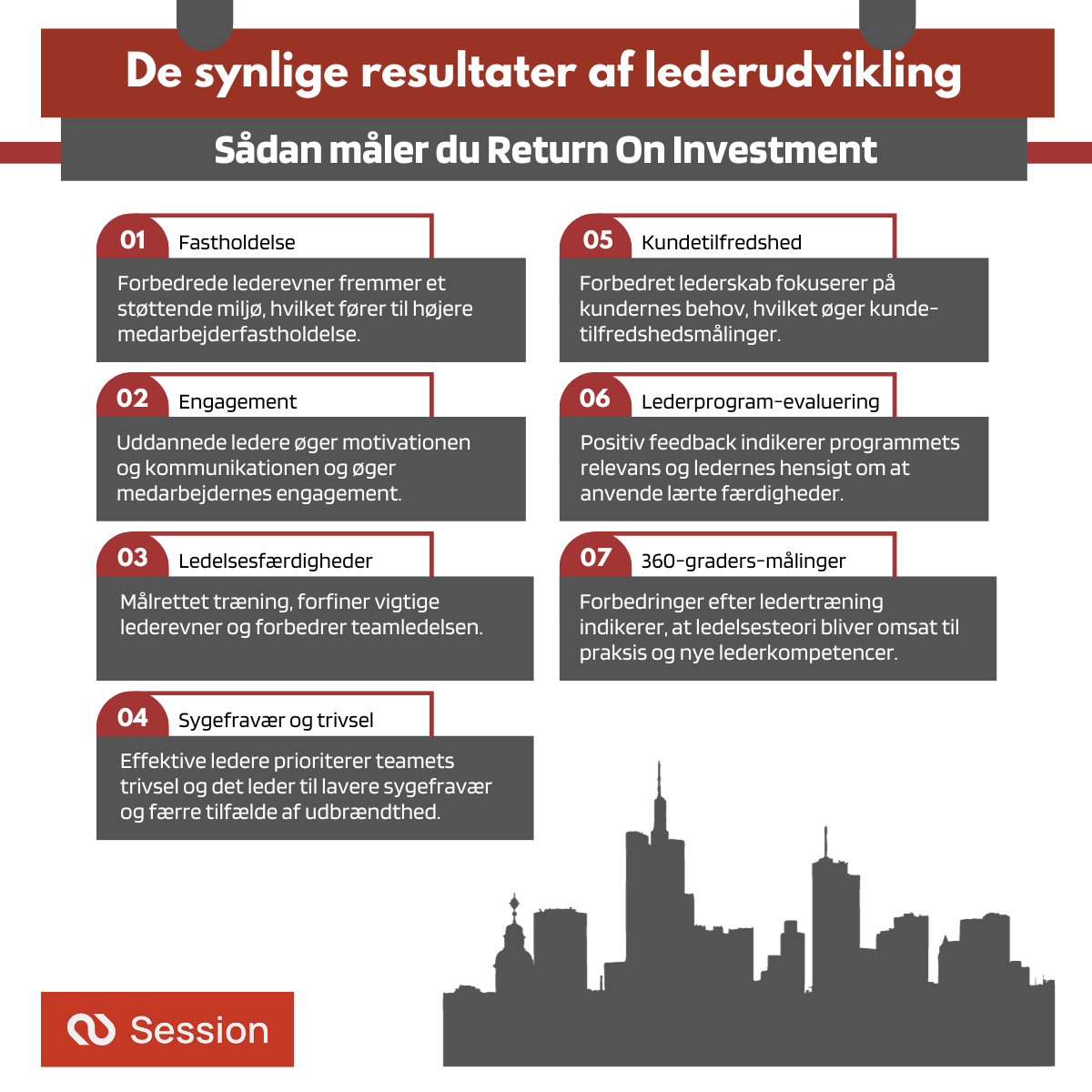Investering i lederuddannelse og træning er en vigtig drivkraft for succes for enhver virksomhed. God ledelse giver bedre og gladere medarbejdere, hvilket ikke kun øger engagementet blandt medarbejderne, men også sikrer højere fastholdelse og bedre ydeevne.
En nylig udført undersøgelse viste, at det at køre førstegangs ledere gennem et lederudviklingsprogram gav et ROI på 29 % i de første 3 måneder og et årligt ROI på 415 %! Det betyder, at virksomheden tjente 4,15 USD for hver 1 USD brugt på træningen.

Behøver vi sige mere? Ja, det gør vi. For strammere økonomiske forhold har tvunget mange virksomheder til at skære ned på deres budgetter. Mange steder bliver der sparet på trænings- og udviklingsprogrammer, inklusiv lederudviklingsprogrammer, og det bliver mere og mere efterspurgt og vigtigt, at man kan bevise hvilken “Return On Investment” man får af de tiltag, man sætter i værk. HR og learning and development (L&D) må derfor indstille sig på at kunne måle virkningen af deres programmer, for at kunne retfærdiggøre udgiften af dem.
Men hvordan kan man måle og retfærdiggøre programmerne mere præcist? I denne guide gennemgår vi hvilke ting, man skal tænke over og spørge til, inden man sætter i værk, samt giver nogle anbefalinger til hvilke målinger, der med succes kan vise ROI af lederudviklingsprogrammer generelt.
Definer mål og succeskriterier for programmet
For at kunne måle effekten af dit lederudviklingsprogram, må du først definere formålet med og succeskriterierne for programmet. For at gøre dette skal du kunne besvare tre konkrete spørgsmål:
- Hvilke problemer står vi overfor, som lederudviklingsprogrammet bør adressere og gøre noget ved? Det kan for eksempel være, at virksomheden oplever for mange kundeklager eller har en alt for lav engagements score internt.
- Hvilken form for adfærd tror vi vil føre til forbedring inden for disse problemområder? Det kan for eksempel være, at lederne efter gennemførelsen af programmet, bliver bedre til 1:1 samtaler og til at opbygge en stærk kultur med løbende feedback.
- Hvad vil vi gerne se ske, når programmet er gennemført? Hvad vil være konkrete og håndgribelige tegn på, at programmet har været en succes, og at det har været investeringen værd? Det kan for eksempel være bedre fastholdelse, at lederne har fået et fælles sprog og en fælles måde at opføre sig på (der er i overensstemmelse med virksomhedens værdier), en høj kunde- og medarbejdertilfredshed eller lign. Vi gennemgår nogle af de mest almindelige målinger for at bevise ROI nedenfor.
Udover ovenstående spørgsmål, må virksomhedens overordnede strategiske retning tages med i betragtning, når det skal besluttes, hvilken slags konkret adfærd ledelsesprogrammet skal træne lederne i. Virksomheden kan komme til at bruge penge og tid på et mere generaliseret lederudviklingsprogram, der ikke direkte hænger sammen med det, organisationen overordnet ønsker at fremme. Så sørg for at have klare succeskriterier og målsætninger for programmet, som du nemt kan evaluere efter programmet er afsluttet, og som direkte kan kobles til din virksomheds samlede succes.
Målinger der beviser ROI
Ifølge en artikel af SHRM indsamler kun 18 % af virksomheder relevante data, der kan understøtte værdien af de lederudviklingsprogrammer, de sætter i værk, hvilket i sig selv kan være grunden til, at nogle kommer til at sætte spørgsmålstegn ved værdien!
I det følgende gennemgår vi nogle eksempler på målfaste mål, der kan bevise den forretningsmæssige case for din investering og gøre det konkret, hvilken ROI virksomheden har fået af træningen:
- Fastholdelsesprocent. Bliver de medarbejdere, der deltog i lederudviklingsprogrammet, længere end den gennemsnitlige medarbejder? Stiger den overordnede fastholdelsesprocent i virksomheden i halen på implementeringen af programmet?
- Engagements-målinger. Engagements scorer viser meget direkte, om investeringen i lederuddannelsen har været umagen værd. Mange undersøgelser viser, hvordan engagement hænger sammen med præstation, derfor er dette et mål, du ikke må glippe.
- Ledelsesfærdigheder. At måle fremskridt inden for konkrete lederevner, der er blevet trænet som en del af lederudviklingsprogrammet, er en fantastisk måde hvorpå man direkte kan bevise fordelene ved og ROI af træningen. Man kan f eks se på, hvorvidt lederne (ifølge medarbejdere og relevante andre interessenter) er blevet bedre til at kommunikere, give feedback og lede forandringer.
- Sygefravær og generel trivsel. Procentdelen af sygemeldte medarbejdere samt deres generelle trivsel før og efter lederudviklingsprogrammet, kan meget håndfast vise, om lederudviklingsprogrammet har flyttet noget i en positiv retning (i de tilfælde, hvor sygefraværet falder og rapporteret trivsel og lykke stiger) eller ej.
- Kundetilfredshed. Hvad var nps-scoren før programmet kørte?Hvad er den efter? Hvad med antallet af kundeklager? Eller den kvalitative feedback, du får fra kunder, herunder kommentarer på for eksempel Trustpilot?
- Lederprogram-evaluering. Hvor højt vurderer deltagerne i lederudviklingen selve programmet? Hvor tilfredse var de med den overordnede kvalitet, underviserne, indholdet, mødestedet - og hvor meget føler de selv, de har fået ud af programmet? Var det - efter deres mening - investeringen værd?
- 360-graders-målinger. Viser hvor højt kollegaer og medarbejdere omkring deltageren i lederudviklingsprogrammet scorer den faktiske adfærdsændring hos lederen. De indikerer, hvor godt læringen fra træningen er blevet omsat til daglige aktiviteter, som ses og opleves af medarbejdere, kunder, lederens egen leder, bestyrelsen eller andre stakeholders.
Ovenstående data kan meget håndfast være med til bevise ROI af din investering i lederudviklingsprogrammet. Dette kan give dig mulighed for at få penge til endnu en udrulning af programmet eller til endnu en investering i et lignende initiativ, der kan styrke ledelsen i din organisation.
Konklusion
I sidste ende bør lederudviklingsprogrammer ikke kun tjene den enkelte deltager, men organisationen som helhed. Måling af ROI på dine programmer sikrer, at organisatoriske mål nås, og at medarbejderudviklingen bevæger sig i den rigtige retning. Som Peter Drucker engang sagde: "Du kan ikke forbedre det, du ikke måler", og det er så sandt, som det er sagt, når det kommer til lederudvikling! Det er ofte let for HR at se, hvorfor en investering i lederudviklingsprogrammer kan være en god idé, men når man skal hente budget til programmet, er det også nødvendigt at kunne vise effekten via konkrete ROI målinger og tal, om ikke før, så sidenhen.
Hos Session ved vi, hvor vigtigt det er at kunne vise effekten af vores coachingforløb. Vi undersøger regelmæssigt hvilken værdi coachingforløbene giver, ved at spørge kollegaer og medarbejdere omkring den, der bliver coachet, ved at lave 360 graders målinger eller ved at se på nps og enps scorer, som det også foreslås ovenfor, at man kan gøre med lederudviklingsprogrammer. Hvis der er flere end 8, der modtager coaching fra samme virksomhed, laver vi endvidere kvartalsvise trendrapporter, med anbefalinger og tips til HR i forhold til hvilke konkrete initiativer coaching samtalerne peger på, at organisationen kunne have gavn af at sætte spot på.
Hvis du er blevet nysgerrig efter at lære mere om hvordan du kan måle og implementere stærke lederudviklingsforløb og coachingrejser i din organisation, så ræk ud til vores team for at lære mere.












